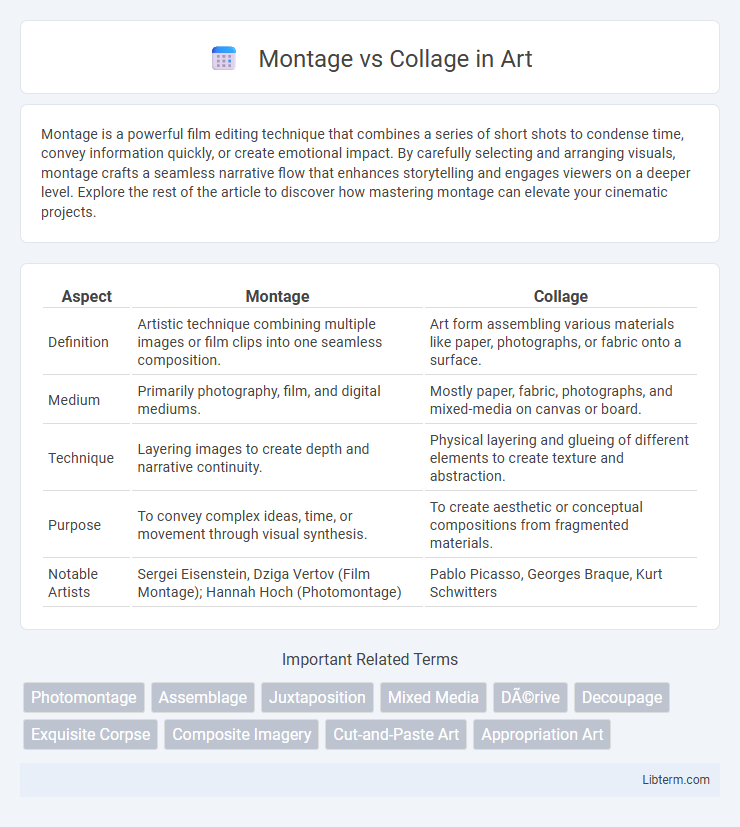Montage is a powerful film editing technique that combines a series of short shots to condense time, convey information quickly, or create emotional impact. By carefully selecting and arranging visuals, montage crafts a seamless narrative flow that enhances storytelling and engages viewers on a deeper level. Explore the rest of the article to discover how mastering montage can elevate your cinematic projects.
Table of Comparison
| Aspect | Montage | Collage |
|---|---|---|
| Definition | Artistic technique combining multiple images or film clips into one seamless composition. | Art form assembling various materials like paper, photographs, or fabric onto a surface. |
| Medium | Primarily photography, film, and digital mediums. | Mostly paper, fabric, photographs, and mixed-media on canvas or board. |
| Technique | Layering images to create depth and narrative continuity. | Physical layering and glueing of different elements to create texture and abstraction. |
| Purpose | To convey complex ideas, time, or movement through visual synthesis. | To create aesthetic or conceptual compositions from fragmented materials. |
| Notable Artists | Sergei Eisenstein, Dziga Vertov (Film Montage); Hannah Hoch (Photomontage) | Pablo Picasso, Georges Braque, Kurt Schwitters |
Introduction to Montage and Collage
Montage and collage are artistic techniques that combine multiple images or elements to create a unified composition. Montage involves assembling a sequence of images or shots, often in film, to convey complex narratives or evoke emotional responses through juxtaposition. Collage, primarily a visual art form, integrates various materials like paper, photographs, and fabric onto a single surface for a textured, layered effect that challenges traditional representation.
Definition of Montage
Montage is a film editing technique that combines a series of short shots into a sequence to condense space, time, and information, creating a unified narrative or emotional impact. Unlike a collage, which assembles various static images or materials in a single composition, montage relies on the dynamic interplay of moving images to convey meaning. Key elements of montage include continuity editing, thematic linkage, and rhythmic sequencing, making it essential in cinematic storytelling.
Definition of Collage
Collage is an artistic technique that involves assembling various materials such as paper, photographs, fabric, and other objects onto a surface to create a unified composition. Unlike montage, which typically merges images to form a seamless visual narrative, collage emphasizes the juxtaposition of different textures and elements to produce a layered, multidimensional effect. This method allows artists to explore contrast, depth, and mixed media by combining diverse fragments into a cohesive artwork.
Historical Origins of Montage
Montage originated in early Soviet cinema during the 1920s, pioneered by filmmakers like Sergei Eisenstein who used rapid editing to create meaning through the juxtaposition of images. This technique contrasts with collage, which has roots in early 20th-century visual arts, notably with artists such as Pablo Picasso and Georges Braque assembling mixed media to create new compositions. Montage emphasizes narrative and emotional impact through film editing, while collage focuses on spatial composition by assembling diverse materials in a single artwork.
Historical Origins of Collage
Collage originated in the early 20th century as a revolutionary art technique popularized by artists like Pablo Picasso and Georges Braque during the Cubist movement. This method involved assembling various materials such as newspaper clippings, photographs, and fabric onto a canvas to create layered, textured compositions. The historical origins of collage highlight its roots in avant-garde experimentation, contrasting with montage, which developed primarily in film as a technique for sequencing images to convey meaning and narrative.
Key Differences Between Montage and Collage
Montage combines multiple images or scenes to create a single, cohesive narrative often used in film to convey the passage of time or complex ideas quickly. Collage assembles diverse materials such as paper, photographs, and textiles into a layered artwork, emphasizing texture and visual contrast without a linear story. Montage emphasizes temporal sequencing and thematic unity, while collage focuses on spatial arrangement and aesthetic juxtaposition.
Techniques Used in Montage
Montage techniques in filmmaking involve the rapid sequence of images edited together to convey a specific idea, emotion, or narrative progression, often through methods like metric, rhythmic, tonal, overtonal, and intellectual montage. These techniques manipulate timing, pace, and visual rhythm to create symbolic or thematic meaning beyond simple continuity. Montage contrasts with collage by actively constructing meaning through dynamic visual sequencing rather than simply assembling static images or materials side by side.
Techniques Used in Collage
Collage techniques involve assembling various materials such as paper, fabric, photographs, and found objects onto a surface to create a unified artwork. Artists often use cutting, tearing, layering, and glueing to combine textures and visual elements that contrast or complement each other. This tactile process emphasizes physical manipulation and material juxtaposition, distinguishing collage from the primarily photographic or digital compositions found in montage.
Applications in Art and Media
Montage involves assembling disparate images or video clips to create a cohesive narrative or thematic message, frequently used in film editing and advertising to convey complex ideas quickly. Collage combines various physical or digital materials like paper, photographs, and fabric to produce layered visual artworks, popular in mixed media art and graphic design. Both techniques enhance storytelling and visual impact but serve different creative purposes across art and media.
Choosing Between Montage and Collage
Choosing between montage and collage depends on the desired narrative effect and visual cohesion; montage arranges sequential images or clips to convey a specific progression or story, while collage layers diverse visual elements to create a unified artistic composition. Montage is ideal for dynamic storytelling and emphasizing temporal relationships in film or photography, whereas collage excels in artistic expression by juxtaposing disparate textures, images, or themes within a single frame. Understanding the communicative goal and medium helps determine whether montage's temporal sequencing or collage's spatial synthesis better suits the project.
Montage Infographic

 libterm.com
libterm.com